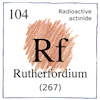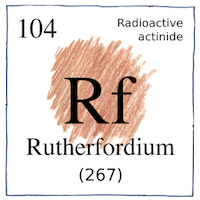Berkeley—Albert Ghiorso,
Matti Nurmia,
James Andrew Harris,
Kari Eskola,
Pirkko Eskola
elements

|
Rutherfordium
In 1964, scientists at Dubna tried to synthesize element 104 by bombarding plutonium-242 with neon-22 ions and had trouble characterizing their results as their experiment produced multiple isomers that decayed in a flury. * In 1969, scientists at Berkeley tried to synthesize element 104 by bombarding californium-249 with carbon-12 ions and were able to measure the decay of rutherfordium-257 and its daughter nobelium-253.
Atomic number 104
Sixteen radioisotopes and four isomers created by particle accelerators some by hot fusion some by cold some by direct fusion and some by decay.
Shining
Artificial and heavy, it won’t hold together. Forget the plan; forget the schedule. If it feels right, if it makes sense, its beauty shines for more than a moment.



Tbe Soviet team responsible for the experiments in 1964—Georgy Flyorov, Yuri Tsolakovich Oganessian, Yu. V. Lobanov, V. I. Kuznetsov, V. A. Druin, V. P. Perelygin, K. A. Gavrilov, S. P. Tretiakova, and V. M. Plotko—are sometimes given credit for also discovering rutherfordium; however, naming rights went to the Berkeley team because their results were more definitive.
See also in The book of science:
Readings in wikipedia:
Other readings: